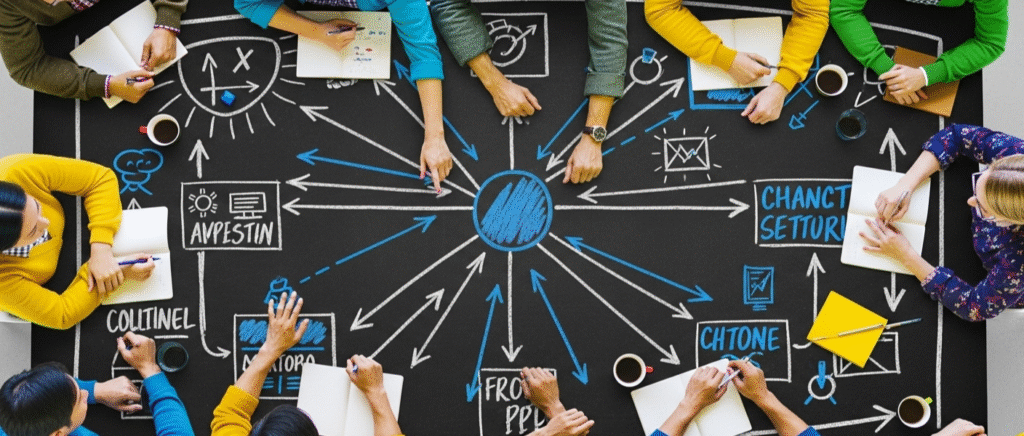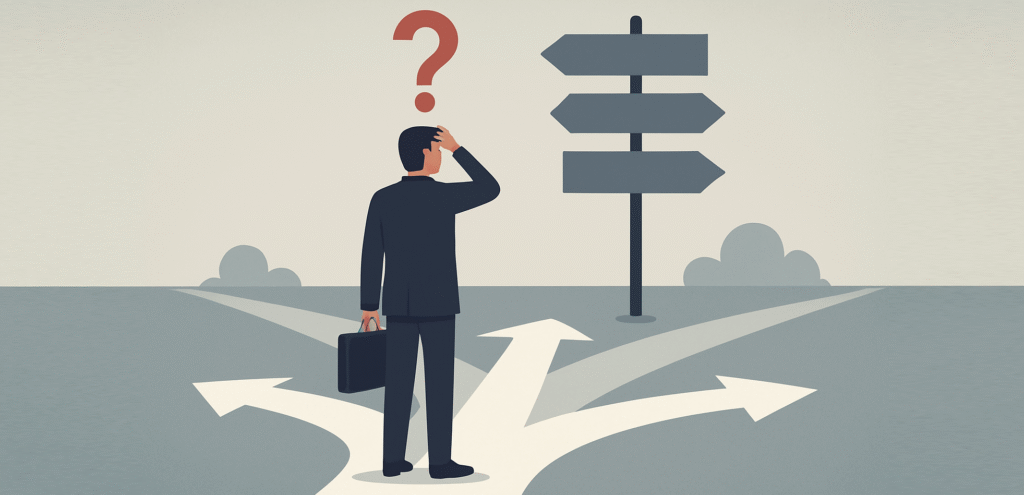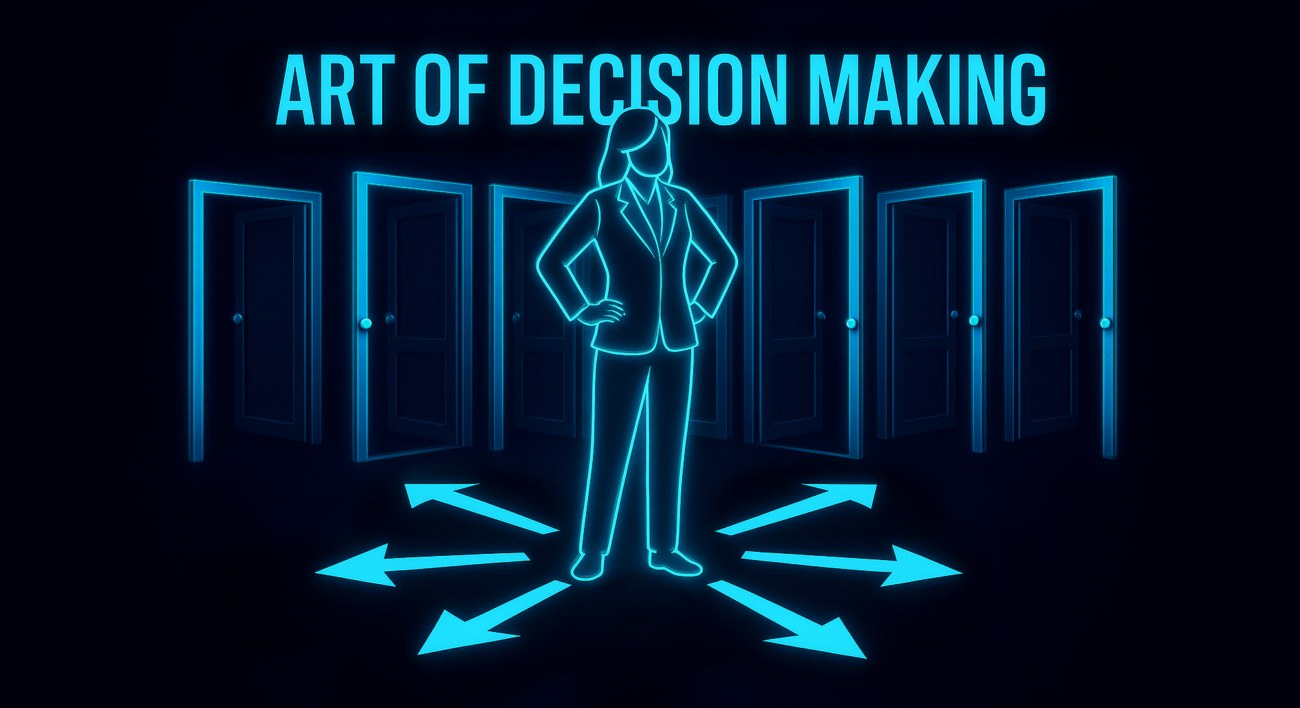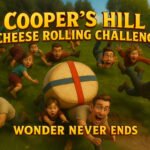Let’s travel back to the 19th century and meet a young naturalist, Charles Darwin. He wasn’t pondering the evolution of species at this moment, but a far more personal dilemma: should he marry? In a now-famous letter, Darwin meticulously crafted a list of “Marry” versus “Not Marry.” On one side, he listed the joys of a “constant companion,” the charm of children, and the comfort of a home. On the other, he noted the “terrible loss of time,” the forced visits to relatives, and the financial burden. This methodical approach from a brilliant mind highlights a universal human struggle, a core challenge of the art of decision-making.
Fast forward to today. We live in a world overflowing with options. From the countless shows on streaming services to the endless career paths we can pursue, modern life has become a labyrinth of choices. This abundance, however, hasn’t necessarily made life easier. Psychologist Barry Schwartz termed this phenomenon the “paradox of choice.” He argued that while we desire options, too many can lead to indecision, anxiety, and what’s known as analysis paralysis. We spend so much time weighing alternatives that we often end up dissatisfied with the final outcome, haunted by the ghost of “what if.” The core of our struggle lies in the intricate psychology of choice.
This article will guide you through the maze of your own mind. We will explore why we often fail to choose wisely and uncover the hidden mental traps that cloud our judgment. More importantly, we will equip you with practical tools and a philosophical framework to navigate life’s crossroads with greater confidence and wisdom. This is your guide to mastering the art of decision-making.
The Psychology of Choice: Why We Fail to Choose Wisely
To make better decisions, we first need to understand the internal forces at play. Our brains are complex, often working in ways that are counterintuitive. The psychology of choice reveals a constant tug-of-war between our immediate feelings and our long-term logic.
The Battle of Two Minds: System 1 vs. System 2
Nobel laureate Daniel Kahneman revolutionized our understanding of this internal conflict with his concept of two systems of thinking.
- System 1: This is your fast, intuitive, and emotional mind. It operates automatically and is responsible for most of our daily, split-second decisions. Think of ducking when a ball flies towards you or getting a “gut feeling” about a person. It’s efficient but also prone to error and bias.
- System 2: This is your slow, deliberate, and analytical mind. It requires effort, attention, and energy. This is the system you engage when solving a complex math problem or carefully weighing the pros and cons of a major life change, like Darwin did.
The problem is that our brains conserve energy, so we heavily rely on the less demanding System 1. This reliance means many of our most important choices are swayed by unconscious feelings and mental shortcuts, rather than careful reasoning. This internal struggle is a primary source of poor judgment and a key focus in improving our decision-making skills.
Unmasking the Saboteurs: 5 Common Cognitive Biases
At the heart of flawed decision-making are cognitive biases, which are systematic patterns of deviation from rational judgment. They are mental shortcuts, or heuristics, that our brains use to simplify information processing. While often useful, they can severely distort our perception of reality. Let’s expose five of the most common culprits. developdiverse
- Confirmation Bias: The Echo Chamber in Your Head
This is the tendency to search for, interpret, and recall information in a way that confirms our pre-existing beliefs. If you believe a certain political candidate is dishonest, you’ll actively seek out news stories that support that view while dismissing any evidence to the contrary. It’s like living in an echo chamber where your own opinions are constantly reinforced, making it incredibly difficult to consider alternative perspectives. This bias is a major obstacle to objective thinking and a critical area to address when learning the art of decision-making. - Sunk Cost Fallacy: Chasing Yesterday’s Losses
Have you ever continued watching a terrible movie simply because you paid for the ticket? Or stayed in a failing project because you’ve already invested so much time and effort? That’s the sunk cost fallacy. It’s our irrational tendency to stick with an endeavor because of past investments, even when it’s clear that cutting our losses is the better option. We become emotionally attached to our “sunk costs” and make decisions based on past commitments rather than future potential. - Availability Heuristic: The Trap of Vivid Memories
This bias involves overestimating the likelihood of events that are more easily recalled in our memory. Because news reports of plane crashes are dramatic and widely publicized, we might fear flying more than driving, even though statistics show driving is far more dangerous. The vividness and emotional charge of the memory make it seem more common than it is. This shortcut can lead to skewed risk assessment and poor choices, making it a critical consideration in the psychology of choice. - Loss Aversion: The Pain of Losing Outweighs the Joy of Gaining
Psychologically, the pain of losing something is about twice as powerful as the pleasure of gaining something of equal value. This fear can make us overly cautious and resistant to change. We might turn down a promising but uncertain job opportunity to stick with a stable but unfulfilling one. The potential loss of security looms larger than the potential gain of a more rewarding career. This aversion to risk is a powerful force that can paralyze our ability to make better decisions. - Overconfidence Bias: The Illusion of Superiority
This is the tendency to have excessive confidence in our own abilities and judgments. A classic example is that a vast majority of drivers believe they are better than average, which is a statistical impossibility. This bias can lead us to take unnecessary risks, underestimate challenges, and fail to learn from our mistakes because we attribute failures to external factors rather than our own errors. Recognizing this bias is a humble but necessary step toward better decision-making skills.

Practical Tools for Far-Sighted Decisions
Understanding our mental flaws is the first step. The next is to equip ourselves with practical strategies to counteract them. Improving your decision-making skills involves moving from reactive choices to proactive, structured thinking.
Deconstructing the Decision: The Power of Mapping
Complex decisions can feel like an tangled knot of financial, professional, emotional, and social considerations. Trying to solve it all in your head is a recipe for overwhelm. Inspired by thinkers like Steven Johnson, the technique of “decision mapping” allows you to externalize the problem.
Imagine you’re deciding whether to move to a new city for a job. A decision map would involve:
- Creating a Mind Map: Put the core decision at the center.
- Branching Out Dimensions: Create main branches for key areas: Career, Finances, Social Life, Personal Growth, Family.
- Adding Sub-Branches: Under each dimension, list the specific factors. For “Finances,” you might have “Salary Increase,” “Cost of Living,” “Moving Expenses,” and “Spouse’s Job Prospects.”
- Connecting the Dots: Draw lines between related factors. The “Salary Increase” might positively impact your ability to afford a better lifestyle (“Personal Growth”), but the “Cost of Living” could negate that gain.
This visual approach helps you see the interconnectedness of the issues and clarifies the trade-offs you need to make. It transforms a messy internal debate into a structured, manageable problem.
Simulating the Future: A Mental Time Machine
Our brains are natural simulators. We can use this ability to test-drive our decisions before we commit.
- Imagine Success: Spend time vividly picturing your life if the decision turns out wonderfully. Imagine yourself one year, or even five years, down the line. What does your daily routine look like? What new opportunities have opened up? This isn’t just wishful thinking; it helps clarify your goals and strengthens your motivation.
- Conduct a “Pre-mortem”: This powerful technique, developed by psychologist Gary Klein, is the opposite of a post-mortem. Instead of analyzing a failure after it has happened, you imagine beforehand that your plan has failed spectacularly. Gather your team (or just yourself) and ask: “It’s a year from now, and this decision has been a complete disaster. What went wrong?” This exercise flips the script on cognitive biases like overconfidence. It legitimizes dissent and encourages critical thinking, helping to uncover hidden risks and weaknesses in your plan that you would have otherwise overlooked.
Broadening Your Vision: The Power of Smart Consultation
We are often trapped in our own limited perspective. To make better decisions, we need to deliberately seek out different viewpoints.
- Harness the Power of Diversity: Research by Samuel Sommers on mock juries has shown that racially diverse groups deliberate longer, consider more facts, and make fewer factual errors than all-white groups. This isn’t just about the contributions of the minority members; the mere presence of diversity makes everyone in the group more careful and thorough in their evaluations. When facing a tough decision, seek advice from people with different backgrounds, experiences, and ways of thinking than your own.
- Learn from Stories: Literature, film, and even history are vast laboratories of human experience. They allow us to witness characters facing immense decisions, grappling with their motivations, and living with the consequences all without us having to pay the real-world price. Analyzing the choices of a character in a novel or a historical figure can provide profound insights into the psychology of choice and offer new frameworks for thinking about our own dilemmas.
What’s Your Decision-Making Style?
“When faced with a choice, do you aim for the ‘perfect’ outcome or the ‘good enough’ one? Our decision-making styles vary dramatically. Answer the following five questions to discover your personal style and learn how it shapes your life.”
Analyzing your style…
The Final Philosophy: Acceptance and Sufficiency
Even with the best tools, the art of decision-making is not about achieving perfection. It’s about developing a healthier relationship with choice itself. The final piece of the puzzle is philosophical, involving a shift in mindset.
The Maximizer vs. The Satisficer: The Quest for “Good Enough”
Barry Schwartz categorizes decision-makers into two types:
- Maximizers: These individuals are obsessed with making the absolute best choice possible. They exhaustively research every single option, terrified of missing out on something better. This endless search often leads to anxiety and, paradoxically, less satisfaction with their final choice.
- Satisficers: These individuals have a set of core criteria and choose the first option that is “good enough” to meet them. They don’t worry about the possibility of a theoretically “perfect” option. Research consistently shows that satisficers are generally happier and more content with their decisions.
To make better decisions and live a happier life, strive to be more of a satisficer. Define your essential requirements and, once you find an option that meets them, make the choice and move on.
Embracing Uncertainty and the Limits of Control
A fundamental truth of life is that we can never be 100% certain about the outcome of our decisions. The goal of mastering the art of decision-making is not to find a magic formula that guarantees success. It is to make the best, most informed decision possible with the information and tools available, and then to accept the inherent uncertainty of the future.
The Hedonic Treadmill: Understanding Temporary Happiness
Psychologists use the term “hedonic adaptation” or the “hedonic treadmill” to describe our tendency to return to a relatively stable level of happiness despite major positive or negative life events. That new car or big promotion will bring a surge of joy, but that feeling is usually temporary. After a while, we adapt, and that new reality becomes our baseline. Understanding this concept is liberating. It reduces the immense pressure we put on single decisions to bring us lasting happiness. It teaches us that contentment is less about achieving perfect outcomes and more about enjoying the process and appreciating what we have.

Conclusion: From Confusion to Wisdom
The journey from being overwhelmed by choices to making them with clarity is the essence of mastering the art of decision-making. It is not a secret gift bestowed upon a lucky few, but a set of decision-making skills that can be learned and honed.
The path involves a profound shift in awareness and strategy. It begins with understanding the internal battle between our intuitive and analytical minds and recognizing the subtle cognitive biases that lead us astray. It continues with the disciplined use of practical tools mapping out complexity, simulating potential futures, and seeking out diverse perspectives to break free from our own echo chambers.
Ultimately, it culminates in a philosophical shift toward acceptance. By embracing the “good enough” mindset of the satisficer, acknowledging the limits of our control, and understanding the fleeting nature of outcome-based happiness, we can lift the enormous weight of needing to be perfect.
Making a decision is not the final act; it is the beginning of a new path. With wisdom as your guide and these strategies as your compass, you can navigate the endless crossroads of life not with fear and hesitation, but with confidence, purpose, and peace of mind.

Imagine a world of miniature cities run by millions, where residents are farmers, soldiers, and architects. Our guide, 20 Incredible Facts About bees and ants, reveals the secrets of these societies, from dancing bees to slave-making ants. Their hidden world will astound you. To read more mind-blowing stories from the natural world.












